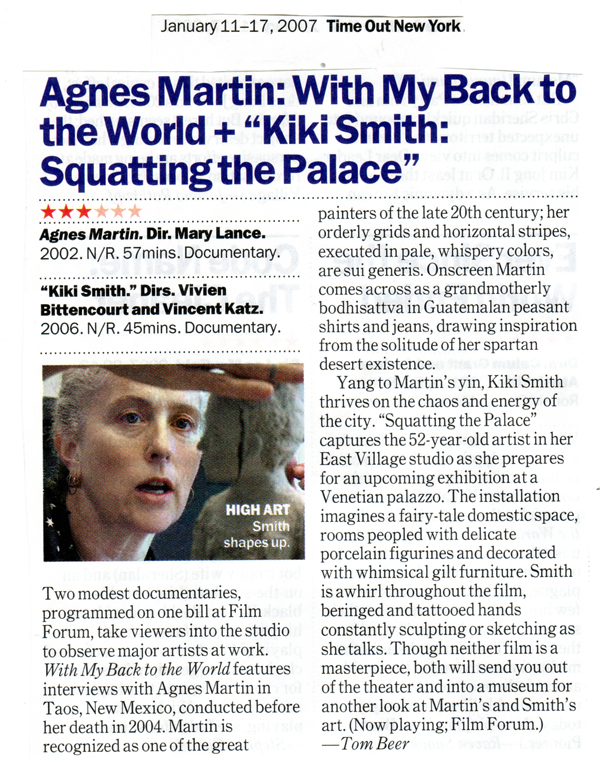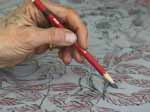Art News
Independent Film Quarterly
Show Business Weekly
Newsday
New York Times Urban Eye Newsletter
The New York Post
Village Voice
New York Magazine
Time Out
Review in DVD Talk
Art News / November 2006
There's No Place Like Home
"This is the grand scheme of the last two years," announces Zachary Wollard, a studio assistant to Kiki Smith, gesturing toward a diagram pinned to the wall. Drawn on paper 35 napkin in Smith's distinctive hand is the layout for her sitespecific installation at last year's Vennice Biennale, Homespun Tales: Stories of Domestic Occupation. The scene appears in Squatting the Palace: an Installation by Kiki Smith in Venice, a documentary directed by Vivien Bittencourt and Vincent Katz (son of painter Alex Katz) that will be shown in New York at the Philoctetes Center on the 30th of this month. According to Katz, the napkin is a suitable emblem of Smith's "very spontaneous and free-flowing" creative process.
As the film shows, Smith works not in a studio but in the living room of her East Village town house. "Her daily life is organized around her art process," says Katz, who filmed her fashioning a leaf from clay and hammering out a bio with a curator. In another scene, Smith paints a porcelain figure and speaks about growing up with her father, Minimalist sculptor Tony Smith, in a house that likewise doubled as a studio.
Many of the works in progress in the film ended up in the artist's eight room installation at Venice's Fondazione Querini Stampalia. Smith created interiors that conjured a domestic life for the 16th century palace, but the spartan furniture and botanical wall stencils were more reminiscent of colonial America that Renaissance Italy. Smith explains in the film, "I have some weird idea about Americans squatting the space."
–Sarah P. Hanson
Independent Film Quarterly / November 2006
Squatting The Palace: An Installation by Kiki Smith in Venice
Evoking the intimacy of a home video, Squatting the Palace is valuable in intimately documenting the creative process of one of modern art’s more intriguing practitioners, Kiki Smith. The film is a creative collaboration between the filmmakers Vivien Bittencourt and Vincent Katz along with the Checkerboard Film Foundation. Checkerboard’s purpose is to create and present films that document the exploits of important American artists for both educational institutions and archives primarily. However, as evidenced by the Smith film, this is a company that anyone interested in pursuing the arts should take a serious look at.
The film itself follows Smith and her assistants as she prepares an exhibition of original work from initial concept to final exhibit. Ultimately, the sketches and pieces that she works on in her townhouse becomes the final show, Homespun Tales: Stories of Domestic Occupation. This particular show was apart of the 2005 Venice Biennale and was well-received by the exhibition’s visitors. The true value of this film lies in recording the process of creation in its most mundane detail. Watching Smith work on sketches or molding clay into sculptures is both fun to watch in terms of seeing actual creation yet it shows the process as being intimate and not exactly awe inspiring. What we see is Smith’s attention to detail as she works her given materials into the forms that she responds to. In turn, various people comment on the skill and detail of her work and how that sets her apart from contemporaries. The first section of the film concentrates as both Smith herself and her assistants go from sketches and rough ideas to getting their hands on clay, wood, etc. and beginning to shape the pieces that will become the final exhibit. Along the way, Kiki talks about her own upbringing and parents’ influence on how she lives her life and how she approaches her work.
The next section of the film concludes with the majority of pieces ready and going to Venice itself to check out the exhibit space and prepare it for the show. There are some great sequences of Smith’s assistants scurrying about the city, collecting and moving materials from place to place in Venice which at times takes on an almost slapstick comedy feel. While preparing the space there, Smith discusses her growing with to do exhibits in established spaces dissimilar from standard museums. Interestingly, she talks about how boring it is to show one’s work in a neutral, empty space as modern museums offer and how it is more engaging to have work displayed in spaces with existing décor, which inevitably results in a dialectic tension which highlights both the work and space more effectively. She hints at her interest in focusing future work in such site-specific avenues as it opens up more creative opportunities for the artist to work with.
Ultimately, the space comes together and the exhibition is launched. The viewer is then treated to the finished pieces displayed in their proper context. What one has been watching in pieces over the course of the film is finally viewed as intended and all doubts as to Smith’s talent and importance are laid to rest. The film allows the viewer to view with baby steps the gradual creation of this work so that when the final exhibit is displayed, the full impact is allowed to register and one is taken aback by the full power of the finished work in context and more fully appreciates Smith’s vision in being able to conceptualize such an exhibit and then quietly go about in its execution. That becomes the final testament to Smith in this film, one that is worth viewing for anyone interested in not only Kiki Smith’s art but Kiki Smith itself and the process of artistic creation itself.
By IFQ Critic Todd Konrad
Show Business Weekly
Agnes Martin: With My Back to the World
Directed by Mary Lance
Kiki Smith: Squatting the Palace
Directed by Vivien Bittencourt & Vincent Katz
Film Forum made an interesting choice by screening the short documentaries “Agnes Martin: With My Back to the World” and “Kiki Smith: Squatting the Palace” back-to-back as one film. While both women do have some similarities, it’s their differences that the films truly underscore.
“With My Back to the World” is first, and quickly lulls the viewer into a mellow mood. Director Mary Lance chose not to use background music or outside interviews for her film. Instead, the entire piece consists of painter Agnes Martin, either working in her New Mexico studio or sitting in an echoing art museum reflecting on her life and work, interrupted only by segment titles and an occasional question from the director. The effect is one of an informal conversation or confessional, and is fitting for an artist who says, “You can’t be an artist if you can’t be alone.” The shots of Martin at work are also revealing. She shows a sheet of calculations that she uses to transfer an image from her mind to a canvas. The painter, who was in her late eighties when the film was shot, paints with a rhythmic hand and seems as if she uses her work as a period of quiet meditation.
Martin could not be more different an artist than Kiki Smith. Coming from the mellow feeling of the Martin doc, the fast-paced “Squatting the Palace,” which follows Smith as she prepares an art installation for the Fondazione Querini Stampalia in Venice, Italy, can seem jarring. Smith’s workspace, which also happens to be her living room, is a flurry of movement as Smith and her assistants make sculptures, sketches and furniture. Smith’s hands are always in motion. Even when she’s talking to the curator of the exhibit, she is carving pieces for the installation.
“Palace” does a great job of detailing the amount of effort that goes into an installation. Once the artwork is finished, it is all shipped to Venice, unpacked by Smith and her crew and set up (once the walls are painted and stenciled, of course). The background music and sharp editing lend to the frenetic air.
Both films do well to showcase their subjects, whether they are quiet and self-reflective or spirited and outgoing. More importantly, both let their subjects be themselves, offering an intimate and fascinating glimpse into the lives of two artists who happen to be polar opposites.
Review by Elissa Hunter
Newsday / January 12, 2007
One austere, one chaotic, their works come together
The artists Kiki Smith, 52, and Agnes Martin, who died in 2004 at 92, represent antipodal styles and sensibilities. Martin stripped away any hint of the figure and spurned the beauty of the outside world, paring her abstract canvases down to austere interlockings of horizontal and vertical lines. She lived in almost total isolation and thrived on her own company.
Smith has embraced the human body, using its expressive and political power to express loathing, nostalgia, despair and longing. She resides rather chaotically in the East Village, surrounded by assistants and half-finished artwork. Her windows are open to the city's thrum and to the birds fluttering in and out of her living room.
Both are the subjects of documentaries offered on a double bill at Film Forum. "Agnes Martin: With My Back to the World," is by far the less satisfying. Mary Lance, who produced and directed, decided to let Martin speak exclusively for herself, choosing not to break up a convoy of edited interviews with any narration or input from others. Its minimalist format is designed to mirror the artist's aesthetic of reduction.
Martin, a stolid sage, speaks meditatively in strings of generalities. Her painting, she intones, is about happiness and innocence and beauty. Inspiration can be courted only by discarding the intellect and opening oneself up. "You have to wait if you're going to be inspired," she was fond of saying. "You have to clear out your mind, to have a quiet and empty mind." An empty mind is a terrible thing to waste a movie on.
Her vague pronouncements, filed under such headings as "memory," "innocence" and "tranquillity," are interspersed with shots of her delicate, muted canvases, which do not reproduce well on film. Occasionally we glimpse her in the act of painting, her leathery hand still commanding the brush with absolute control. These moments are the highlights of a documentary unlikely to appeal to anyone except Martin's devoted followers.
The buoyant "Kiki Smith: Squatting the Palace" traces the evolution of an art installation destined for a Venetian palazzo. It begins in Smith's cheerfully disordered home/studio, where she is putting together the sculptures, drawings, prints and furniture that will compose an eight-room installation.
She is constantly in motion. Her restless hands are always generating forms: modeling leaves in clay, painting the darkened brows on a frozen figure, sketching in the outlines of flowers. Even her wild gray hair seems kinetic, radiating from her unlined, impish, lovely face.
The documentary crew, directed by Vivien Bittencourt and Vincent Katz, follows Smith and her entourage to Venice. It traces the alchemy of labor and inspiration that goes into assembling the piece, which we see in its final state, surrounded by tourists and admirers.
The vibrant Smith appears to be the diametrical opposite of the impassive Martin. Yet the two films together reveal some unlikely overlaps, besides the fact that the works of both are represented by Pace Wildenstein Gallery in Manhattan. Martin insists that her paintings, seemingly absent of emotion, are expressive at heart. And Smith sounds like Martin when she talks about being at the mercy of inspiration: "You're only partially in charge of your creativity. It has its own agenda."
Copyright 2007 Newsday Inc.
BY Ariella Budick
Newsday Staff Writer

New York Times Urban Eye Newsletter listing:
FILM
Portraits of Two Artists
A tribute to a straight-talking iconoclast, the new film “Agnes Martin: With My Back to the World,” depicts the engaging artist and critic, in her 80s at the time, “simply as an interesting neighbor who happens to paint for a living,” says Neil Genzlinger. Meanwhile, “Kiki Smith: Squatting the Palace”is a slightly more obtuse look at the slightly more obtuse artist, whose work currently graces the Whitney. Seen as a double bill, the two films present artists with very different approaches, but perhaps one unifying outlook. As Ms. Smith says, “The main thing in making art often is letting go of your expectation and your idea.”
The New York Post
Artistic Opposites Attract At Forum
January 10, 2007 -- KIKI Smith and Agnes Martin are respected female artists. The similarities end there, however, as two well-made short films at Film Forum explain.
"Kiki Smith: Squatting the Palace" studies the frizzy-haired, multi-tattooed woman as she works in her East Village house preparing sculptures, paintings, drawings and furniture for an eight-room installation at a palace in Venice.
"Different things motivate me," Smith, 52, confesses, "but how it comes out can be very convoluted. You're only partially in control of your own creativity."
While Smith is a vibrant artist who travels the world with a retinue of assistants (or so it seems), the subject of "Agnes Martin: With My Back to the World" was a recluse who spent the last 40 years of her life in solitude in Taos, N.M.
Sitting in her Taos studio, she talks about painting (grids and horizontal lines were her forte), her early years in rural Canada, the decade she lived in New York in a spacious studio that cost just $45 a month, and her chosen lifestyle: "You can't be an artist if you can't be alone."
Named one of the 10 greatest living artists in a 1999 story in ARTnews magazine, Martin died in 2004 at age 92.
An exhibition of Smith's varied output is at the Whitney through Feb. 11.
KIKI SMITH/AGNES MARTIN Total running time: 102 minutes. Not rated (nothing to worry about). At the Film Forum, Houston Street, west of Sixth Avenue.
By V.A. Mussetto
Village Voice
Tracking Shots
Portraits of Two Iconoclastic Women
Kiki Smith: Squatting the Palace; Agnes Martin: With My Back to the World
Film Forum's pairing of these two documentaries— Kiki Smith: Squatting the Palace and Agnes Martin: With My Back to the World—is an inspired study in contrast and complement, one each of the subject-artists would no doubt appreciate. Structured similarly as informal portraits of the artist at work, directors Mary Lance (Agnes Martin) and Vivien Bittencourt and Vincent Katz (Kiki Smith) circle their subjects with unobtrusive deliberation; both documentaries were filmed over the course of several years and reflect the process of finding inspiration. Agnes Martin, who passed away in 2004, fills Lance's frame with confidence. At 91, the Canadian-born painter was still working (or waiting) every day in Taos, New Mexico, and though the veteran of the abstract expressionist movement was famously enigmatic, as hostess she fields questions patiently, moving over her canvas in a striped T-shirt (horizontal, naturally) and jeans. Almost hypnotic in her clarity, you'll be compelled to jot down nearly everything Martin says. "I gave up facts entirely," she sighs, explaining her pursuit of an empty mind in the service of inspiration over ideas. "You'll never find out the truth about life by guessing about facts." Smith, 52, whose work is as thematically and aesthetically opposed to Martin's as it's possible to be, is a more elusive presence on screen. In perpetual, almost pathological motion, Smith fills her Lower East Side home with sketches, sculptures, and people in preparation for an ambitious installation in Venice. Both films refuse to investigate the personal lives of the two iconoclastic women, insisting instead to look at their lives through the portal of their work.
by Michelle Orange
New York Magazine
Kiki Smith: Squatting The Palace
Director: Vivien Bittencourt, Vincent Katz
NEW YORK VIEW
Vivien Bittencourt and Vincent Katz’s intimate documentary chronicles the working life of the Lower East Side sculptor and painter Kiki Smith as she prepares a major installation in Venice. Screening with Agnes Martin: With My Back to the World, a portrait of the reclusive late artist.

Review in DVD Talk
Kiki Smith Squatting the Palace: An Installation by Kiki Smith in Venice
I've gotten a lot of weird ideas about art, working, and art appreciation from this 45-minute look into artist Kiki Smith's process, and I'm sure Smith would like that. Here Microcinema continues its serious yet eminently approachable series of examinations of renowned contemporary artists. As an artist myself, I think I can safely say that you norms out there think we are weird, because we are. And many will be put off by Smith's eccentricities (both in personality and methodology) as displayed in this documentary, yet the tale directors Vivien Bittencourt and Vincent Katz construct from interview/ action segments filmed as Smith prepares for the 2005 Venice Biennale ultimately paints a glowing, complex portrait of the artist.
The filmmakers aren't present; their camera is an observer eliciting compelling ruminations from Smith and others, notably studio assistants. However, the narrative that emerges is a bit like Smith's work for the Biennale, her 'homespun tales.' Just as Smith's drawings, paintings and sculpted ceramic figures (displayed throughout a series of rooms in an historic residence) extend from art history into our subjective world, half-forming seemingly unrelated threads, so do the responses of Smith and others construct organic links between the artist's seemingly haphazard work methods and her own relationship to art history.
The approach is gentle, yet frank, a pretty good match with Smith's forthright eccentricity - she's unapologetic about her unique and scattered nature. Her hands flutter extravagantly as she talks about birds, primitive tattoos flashing and near-dreadlocked hair waving. Nonetheless, we find an artist who is methodical in her own way. Yet as almost the entirety of her Biennale artworks fill her apartment, all in progress at the same time, it's hard to find or understand order. But lest, in such a search for understanding, things get bogged down in artistic pretension, the assistant laughingly shows us Smith's 'two-year plan' for the Biennale; randomly scrawled on a single napkin tacked to the wall. Even Smith herself is a realist as she ascribes to Contemporary American Art a need to let go of expectations: "It will all just look like an art show in the end," she notes.
As the show sets up in Venice, more normalizing humor leaks in, in the form of speeded up footage of her assistants struggling with 119 faux-walnut boxes. We're also treated to some glimpses of Smith running the show in that way only artists can - with shorthand, a gentle, even, but firm hand, and a hands-on approach. A gorgeous 5-minute sequence then dreamily tours the finished exhibit, leaving us alone with the art, as well as showing attendees interacting with it. Remarkably, it makes clear the distillation of all the seemingly disconnected work that's gone before, reinforcing the beauty and power in a way even the average non-artist viewer can relate to.
Capricious synchronicity links the death of the artist's mother with the end of her exhibition at the Biennale, and with the conclusion of this program. Smith's musing on her mom's death is both hopeful, sweet and brave, a fitting description, too, of her figures from Venice, lifting their placid faces to the golden light that acts as an elegy for a sinking city.
By Kurt Dahlke
Edited by TOM PIPER
Color/45 minutes
© 2006 CHECKERBOARD FOUNDATION, INC., New York, NY







